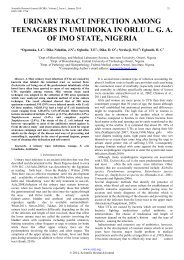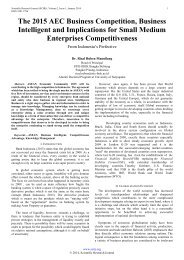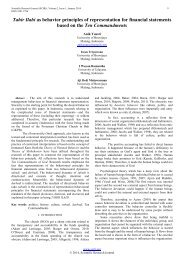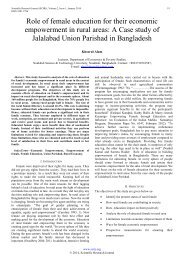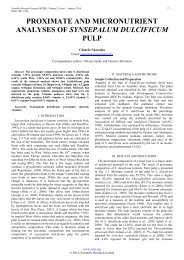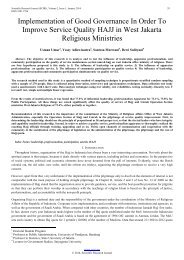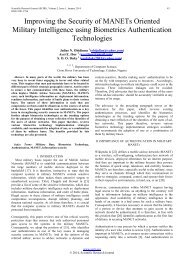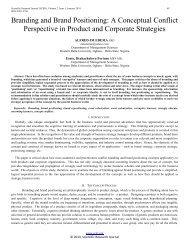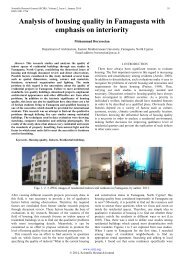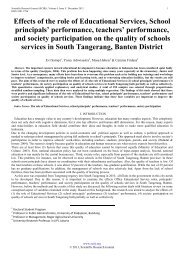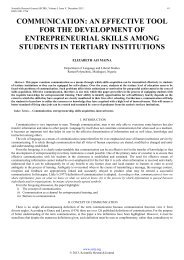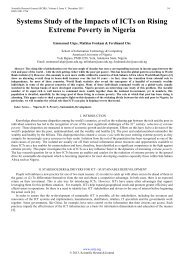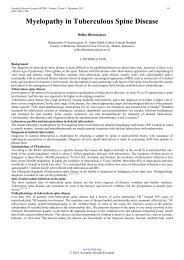RELATIVE EFFICACY OF ARTESUNATE OR AMODIAQUINE COMBINATION THERAPIES WITH SULPHODOXINE-PYRAMETAMINE IN CHILDREN WITH UNCOMPLICATED PLASMODIUM FALCIPARUM MALARIA IN BORNO STATE, NIGERIA
The study was carried out in the malaria holo-endemic settlements around Lake-Alau, Borno State, Nigeria between July to December, 2011. The aim was to compare the efficacy of Artesunate + Sulphadoxine-Pyrimethamine (AT+SP) and Amodiaquine + Sulphadoxine-Pyrimethamine (AQ+SP) in the treatment of uncomplicated Plasmodium falciparum malaria in children. A total of 313 children (6-59 months) were screened, using standard protocols for therapeutic efficacy studies on fever and parasitaemia and the results were evaluated using regression analysis. The results obtained indicated that 79.6% of the children were cleared of fever by AT+SP as against 78.3% by AQ+SP on the first 24 hours after treatment and achieved a daily rate of temperature clearance of 0.35 0C and 0.29 0C and daily reduction in febrile children of 22.04% and 21.99% with the respective drugs, within the early follow-up days (0 - 3). The remaining febrile were relieved by day 28 and temperatures normalized to 36.0 0C and 36.7 0C with the respective drugs. The results further revealed that both AT+SP and AQ+SP cleared the bulk of the parasites from 21,738 to 30/µl and 19,953 to 66/µl, respectively within the first three days of follow-up; with proportionate success rates of 85.1, 95.2, 99.0, 99.5, 99.9 and 99.9% and 78.7, 93.4, 98.4, 99.4, 99.6 and 99.7% on days 1, 2, 3, 7, 14 and 28, respectively. These translates to mean parasite clearance time of 28.45 hours and 29.92 hours, with concomitant mean fever clearance time of 29.36 hours and 31.65 hours in AT+SP and AQ+SP, respectively. Regression analysis further revealed that each µl of the blood parasites cleared gave a temperature relief of 0.2071 0C and 0.1714 0C with the respective drugs. These results clearly put the efficacy of AT+SP in fever clearance ahead of AQ+SP in both early and late follow-up days. Based on rapid parasite and fever clearance accompanied by faster PCV (%) recovery and higher frequency of adequate clinical and parasitological response (ACPR) of AT + SP (91.4%) it could be adjudged to be superior to AQ+ SP (84.5%). Therefore, the Artesunate based combination therapy (AT + SP) is recommended for control of P. falciparum malaria in children.
The study was carried out in the malaria holo-endemic settlements around Lake-Alau, Borno State, Nigeria between July to December, 2011. The aim was to compare the efficacy of Artesunate + Sulphadoxine-Pyrimethamine (AT+SP) and Amodiaquine + Sulphadoxine-Pyrimethamine (AQ+SP) in the treatment of uncomplicated Plasmodium falciparum malaria in children. A total of 313 children (6-59 months) were screened, using standard protocols for therapeutic efficacy studies on fever and parasitaemia and the results were evaluated using regression analysis. The results obtained indicated that 79.6% of the children were cleared of fever by AT+SP as against 78.3% by AQ+SP on the first 24 hours after treatment and achieved a daily rate of temperature clearance of 0.35 0C and 0.29 0C and daily reduction in febrile children of 22.04% and 21.99% with the respective drugs, within the early follow-up days (0 - 3). The remaining febrile were relieved by day 28 and temperatures normalized to 36.0 0C and 36.7 0C with the respective drugs. The results further revealed that both AT+SP and AQ+SP cleared the bulk of the parasites from 21,738 to 30/µl and 19,953 to 66/µl, respectively within the first three days of follow-up; with proportionate success rates of 85.1, 95.2, 99.0, 99.5, 99.9 and 99.9% and 78.7, 93.4, 98.4, 99.4, 99.6 and 99.7% on days 1, 2, 3, 7, 14 and 28, respectively. These translates to mean parasite clearance time of 28.45 hours and 29.92 hours, with concomitant mean fever clearance time of 29.36 hours and 31.65 hours in AT+SP and AQ+SP, respectively. Regression analysis further revealed that each µl of the blood parasites cleared gave a temperature relief of 0.2071 0C and 0.1714 0C with the respective drugs. These results clearly put the efficacy of AT+SP in fever clearance ahead of AQ+SP in both early and late follow-up days. Based on rapid parasite and fever clearance accompanied by faster PCV (%) recovery and higher frequency of adequate clinical and parasitological response (ACPR) of AT + SP (91.4%) it could be adjudged to be superior to AQ+ SP (84.5%). Therefore, the Artesunate based combination therapy (AT + SP) is recommended for control of P. falciparum malaria in children.
You also want an ePaper? Increase the reach of your titles
YUMPU automatically turns print PDFs into web optimized ePapers that Google loves.
Scientific Research Journal (SCIRJ), Volume I, Issue II, September 2013 33<br />
ISSN 2201-2796<br />
37.0∕µl of the residual parasites daily compared to 24.0/µl by AQ+SP, equivalent to 0.18% and 0.15% parasite clearance,<br />
respectively. In general therefore, the result also suggests faster parasite clearance time (PCT) in AT+SP than AQ+SP.<br />
Effects of the Drugs on Fever<br />
Fig. 2 similarly revealed faster fever (temperature) clearance in AT+SP than AQ+SP as deduced from the coefficient of<br />
determination (r²) values of 65.6% and 76.64%, respectively, during the early follow-up (0-4 days). Mean auxillary temperature at<br />
enrolment was higher in children treated with AT+SP (38.15 0 C) than AQ+SP (37.97 0 C) but the trend was reversed in the later<br />
phase, implying faster fever clearance for AT+SP within the four initial days (Fig. 2a). However, during the late phase, the r²values<br />
for the two drugs were at par. Temperature cleared at the rate of 0.35 0 C for AT+SP as against 0.29 0 C for AQ+SP in the<br />
first four days, 0.50 0 C and 0.05 0 C during later follow-up (7 - 28 days), respectively. Fig. 2b shows that the percentage of febrile<br />
children dropped daily by 22.04% in AT+SP patients compared to 21.99% in AQ+SP patients in the early phase of treatment (0 - 4<br />
days). These results clearly put the efficacy of AT+SP in fever clearance ahead of AQ+SP in both early and late follow-up days.<br />
Effects of the Drugs on Packed Cell Volume (PCV)<br />
Fig. 3 shows that parasites affected PCV by 98.41% in AT+SP patients and 93.51% in AQ+SP patients. Despite a much higher<br />
PCV level observed in children treated with AT+SP (25.69%) than AQ+SP (25.87%) at enrolment, the speed of recovery was<br />
relatively faster in AT+SP (0.0214%) than AQ+SP (0.0180%).<br />
Drug Therapeutic Efficacy<br />
The result in Table 2 did not show cases of early treatment failure (ETF) in either of the drugs, as the case was also for the late<br />
clinical failure (LCF) in AT+SP, however, there was slight (0.06%) indication of late clinical failure for AQ+SP. The cases of late<br />
parasitological failure (LPF) in AT+SP (8.6%) was relatively lower compared to 14.9% in AQ+SP. Total treatment failure (TTF)<br />
was relatively higher for AQ+SP (14.96%) than AT+SP (8.6%). The result for adequate clinical and parasitological response<br />
(ACPR) was also in favour of AT+SP with 91.4% compared to 84.5% for AQ+SP.<br />
Table 1 Baseline characteristics of patients at enrollment<br />
Table II. Therapeutic efficacy of Artesunate + Sulphadoxine-pyrimethamine versus Amodiaquine + Sulphadoxinepyrimethamine<br />
in P. falcifarum infected children<br />
www.scirj.org<br />
© 2013, Scientific Research Journal





